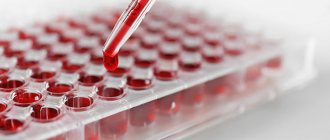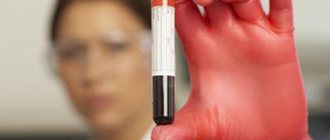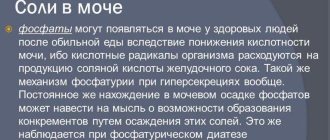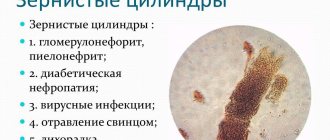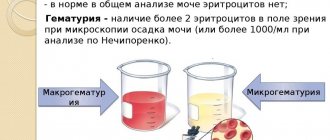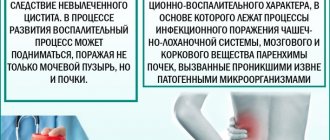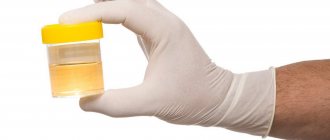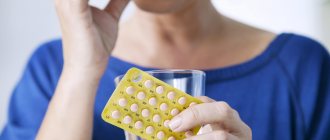What is Sulkowicz's test
This is a laboratory urine test to determine the presence of calcium in urine. The Sulkovich test shows how much of this element is excreted from the body. If an excess (hypercalcemia) or deficiency (hypocalcemia) is detected, this indicates poor nutrition or the presence of various diseases. More often, this study is prescribed to infants to determine the required daily dose of vitamin D.
If there is pathology and the sample interpretation does not comply with generally accepted standards, the patient must undergo additional tests. It is impossible to make an accurate diagnosis based only on Sulkovich’s study; other symptoms must be taken into account that may indicate the presence of a certain pathology. Treatment is prescribed based on medical history and additional tests.
General information about the technique
The Sulkowicz test is a test used in pediatrics to detect calcium in urine. Most often, the technique is prescribed by doctors to diagnose rickets or to select the dosage of vitamin D.
Normally, human kidneys produce urine, which contains uric acid, creatinine, protein, calcium, and so on. A deficiency of calcium affects health, but if there is an excess of this substance, then this is also not the norm. If there is high calcium, seizures may develop or bone tissue will not be able to grow. All these conditions will be helped to identify Sulkovich's reagent, which is used during diagnosis.
As for an adult, he will be prescribed this type of study if there are pathologies in the endocrine system, in order to diagnose hypocalcemia or hypercalcemia. Urine according to Sulkovich should be taken for the purpose of diagnosing hyperthyroidism, hypothyroidism and when using medications containing vitamins A and D, as well as in order to find out whether the norm corresponds to reality.
In addition to the above, this study is applicable if:
- symptoms of nephrolithiasis;
- pancreatitis;
- renal pathology.
It is especially important to assess calcium levels in the presence of the following pathologies:
- granulomatosis;
- oncology;
- problems with the thyroid gland;
- sarcoidosis;
- tuberculosis.
It is also necessary to get tested for prevention, because some pathological processes are directly related to low or high levels of Ca in urine, and such diseases may not show themselves at all.
During the procedure, urine is mixed with Sulkovich's reagent, which contains oxalic acid. That is, half the reagent is added to five milliliters of urine. When these two substances combine, a precipitate is formed that does not dissolve. Calcium, which is present in urine, enters into a special reaction, which leads to a cloudy milky hue.
To identify deviations during the study, you need to compare the result obtained with a special scale, which represents advantages.
There may be from one to four, that is, the result will directly depend on the number of pluses:
- 1 plus represents a weakly positive result, which is basically the norm. But it is necessary to adjust the intake of vitamin D, that is, it is recommended to slightly increase the dosage of the drug.
- Two advantages: the cloudiness is very slight and there is no threat to health, this is practically the norm. In this case, no medications are required, that is, the child receives exactly as much vitamin as he needs.
- 3 pluses, this condition means that there is more calcium than it should be. Here the doctor adjusts the intake of vitamin D, preferring to reduce the dosage, and sometimes completely eliminate it.
- Four pluses, this indicator is characterized by pronounced cloudiness of the urine, since the calcium concentration is high. The result obtained indicates pathology or leaching of calcium salts from the human body. The algorithm of action for such a case is the complete exclusion of any drugs that contain calcium, as well as dietary adjustments.
If calcium in the human body is not normalized, the baby may develop rickets or tooth enamel will not grow sufficiently.
Indications for the test
The Sulkovich analysis is prescribed for both adults and children. More often, this test for calcium in urine is carried out in the pediatric department to determine the required dosage of vitamin D for infants. This is necessary to prevent osteomalacia (softening of the bones), which leads to improper formation of the skeleton and leads to the development of serious diseases.
With excess Ca, convulsive syndrome may begin, which is dangerous to health. If this element begins to be deposited in bone tissue, then skeletal growth slows down. An adult receives a referral for a test if there is a suspicion of:
- pancreatitis;
- hypoparathyroidism;
- sarcoidosis;
- Wilson's disease;
- hyperparathyroidism;
- tetany (convulsive seizures);
- tuberculosis.
- Hemoglobin is normal in the blood
- Diet for gallstone disease
- Stem stitch - how to do it with detailed instructions. Stem stitch embroidery with threads, beads and ribbons
Sulkowicz test in children
This is a mandatory procedure that is performed for all newborn children. A urine test for vitamin D is important especially for a child born in winter or autumn, when there is a lack of sunlight. This is important for phosphorus-calcium metabolism and its regulation, which is part of the process of formation of the bone skeleton and is responsible for the physical and mental development of the child. For children, the Sulkovich test is recommended if the following diseases are suspected:
- pancreatitis;
- periodic tremor of the upper, lower extremities or convulsions;
- suspected Wilson's disease, an inborn error of copper metabolism;
- hypoparathyroidism;
- tuberculosis of the kidneys, lungs, bones;
- formation of granules in the tissues of the kidneys, liver, lymph nodes.
How to correctly collect analysis from infants and older children?
To conduct an analysis according to Sulkovich, a specialist needs a portion of urine, when collecting which it is necessary to adhere to the following recommendations :
- Urine fluid is collected before feeding and only after the child has been thoroughly washed (this will prevent bacteria that accumulate on the genitals from getting into the urine and will allow you to achieve maximum accuracy when interpreting tests).
- To collect urine from newborns, you can use a urinal, which is fixed in the child’s genital area. The liquid from the urine bag is subsequently poured into a clean container.
- In older children or if the baby is caught urinating, the urine is collected directly into a container.
- To collect material from infants in the absence of a urinal, you can use a regular plastic or cellophane bag, make holes in it for the legs and put it on the baby like shorts. In this case, urine can be collected later, after the child has urinated.
- If the child is already old enough and goes into the potty on his own, pouring urine from there is also unacceptable, since even if the potty is washed regularly and thoroughly, foreign microorganisms still remain on its walls, which can affect the composition of the urine for analysis.
- For analysis according to Sulkovich, it is better to use the first morning urine, and you need to give urine in a medium portion: during the first seconds, the child must urinate in the toilet or in a potty, and the next portion of urine is suitable for collection.
It is impossible to squeeze urine out of diapers for testing, since the urinary fluid, upon reacting with absorbent materials, will change its composition, which will negatively affect the accuracy and reliability of test results.
In such cases, it is better to immediately give the child a clean container in which he can urinate (even with the help of his parents).
Read our article on how to collect urine according to Nechiporenko.
Preparing for the test
To conduct a reliable study, it is necessary to follow certain rules for collecting material. You cannot submit urine that was collected 2 hours or yesterday before the test to the laboratory. Under the influence of various factors, the amount of calcium in a person’s body can fluctuate. Before submitting a sample, you should not eat the following foods:
- alcoholic drinks;
- spices;
- chocolate candies;
- strong coffee, tea;
- baked goods made from puff pastry or butter dough;
- fermented milk and dairy products.
Reasons for deviations from the norm
With an increased concentration of calcium in the urine, we can talk not only about rickets. This may be a sign of the following diseases:
In rare cases erroneous results are possible if the child ate foods high in calcium on the day before the test date.
It is possible to say for sure that the above diseases can develop if additional symptoms appear in the form of general weakness of the body, arrhythmia, nausea and an increase in the amount of urinary fluid.
How to identify rickets in children - advice from a pediatrician:
How to collect urine according to Sulkovich
Before collecting the sample, it is necessary to wash the genitals thoroughly. It is recommended to use filtered water and soap without fragrances or foaming additives. The algorithm for collecting material for research according to Sulkovich is as follows:
- For testing, you only need morning urine, which is collected on an empty stomach; you cannot eat or feed the baby.
- During urination, a person produces the 1st, 2nd and last portion of urine. To carry out the test, you will need the last and second; it is very difficult to determine the exact volume in children, but you must try to follow the sampling rules.
- Immediately close the container using the screw cap without touching the inside surface with your hands.
In a baby
In pediatrics, this analysis is one of the main ones. Urine analysis according to Sulkovich is mandatory for infants, but the collection procedure itself is somewhat difficult, so parents should consult in advance on how to properly collect material for testing. The best option would be continuous sampling for 24 hours, but this is extremely difficult to do in infants. As a rule, morning liquid is taken on an empty stomach; special urinals, which are conveniently attached to the baby’s perineum using a bandage and Velcro, help to collect it.
- Strengthening nails with acrylic
- Strawberry compote for the winter
- Ribs in the oven
What is this analysis?
To determine diseases using the Sulkowicz method, a small amount of the child’s urine is mixed with a special solution based on oxalic acid , with which the calcium present in the urine reacts. This leads to the formation of sediment, in which the degree of turbidity of the liquid is determined on a special scale.
You can take such an analysis in private paid laboratories or in children's clinics, but in the first case you can wait for the test results much faster.
Indications for donating urine for research using the Sulkovich method are:
- excessive consumption of vitamins A and D;
- suspected sarcoidosis;
- the likelihood of developing hyperthyroidism and hypothyroidism;
- rickets.
Also, this type of analysis can help recognize cancer formations , against the background of which the body can produce calcium in increased quantities. The Sulkovich method in this case makes it possible to determine with great accuracy the presence of such formations in the thyroid gland.
Decoding
The Sulkovich reaction is carried out in pediatrics to determine the amount of Ca that is excreted from the body along with urine and helps determine the presence of calciuria. When diagnosing infants, it helps to identify rickets. The interpretation is carried out by a doctor who, after adding the reagent, determines the degree of turbidity of the material. More often, this study helps to establish the required dose of vitamin D and monitor the results of treatment.
Normal in children
A urine calcium test in children may indicate the development of certain diseases. If the material does not become cloudy, the result is considered negative. If the doctor cannot accurately determine the degree of turbidity, then the test must be repeated after 3-5 days and the study is marked as doubtful. If there is noticeable turbidity, it is set on a scale from 1 to 4 in the form of a “+” sign. Normally, children without abnormalities in the functioning of the kidneys and other organ systems should have an indicator of 2 “+”; the material shows a slight clouding reaction.
0 points - what does it mean?
In this case we are talking about calcium deficiency in the body. The element does not enter the child's body in sufficient quantities, which can cause rickets, a thin layer of tooth enamel. In adults, this condition indicates a lack of calcium in the foods that a person consumes. A deficiency of this microelement indicates in some cases the development of hypoparathyroidism (weak production of the hormone PTH by the body). This condition requires treatment, increasing the intake of calcium in the body (taking special medications).
The absence of turbidity and sediment during the sample indicates, in some cases, due to the fact that the person took certain medications before collecting the material. In the presence of a malignant tumor, a negative result indicates the appearance of metastases in the human body. A child who does not have enough vitamin D can get 0 points. To avoid the development of complications, children with a negative result are monitored by a doctor.
What does 1 point mean?
This slight cloudiness of the urine when the sample is taken is within the normal range; excess or deficiency of calcium is not observed. In diagnostics, this indicator is considered a medical norm and does not require any additional action. The pathology will be expressed by a sharp clouding during the Sulkovich study. When deciphered, it will be written as 3 or 4 “+” signs, which indicates a high calcium content. A person with the same result will need treatment.
Calcium, what is this trace element?
Calcium is a microelement that occupies one of the leading positions in the functioning of various systems of the child’s body. This is especially important for a developing organism, since this microelement is the basis for the structure of bone tissue, teeth and nails in a child.
In addition, it is involved in the blood coagulation system, is part of the nervous tissue, participates in the conduction of nerve impulses and ensures the normal function of the nervous system. It is one of the elements that ensures the correct rhythm of heart contractions and muscle fibers.
Calcium is part of the system of endocrine glands, participating in the production of certain hormones. Its presence helps reduce allergic manifestations in the body. Calcium, playing such an important role in the development of the child’s body, requires mandatory medical monitoring of its content in the urine.
Deviations from the norm in one direction or another indicate the development of a pathological process in the child’s body.
Invalid results
The results of the Sulkovich analysis in a laboratory study of urine largely depend on the child’s diet. If your diet contains foods rich in calcium, the test result may be distorted. Excessive consumption of dairy products, cheese, greens, and leafy vegetables can lead to excess calcium in the body of a lactating woman.
If an infant receives complementary foods fortified with calcium, as well as breast milk from a mother whose diet has errors, the result of the Sulkovich test may be unreliable. In such cases, the mother of the child should adjust her own diet before taking the Sulkovich test, and the study of the baby should be carried out over time.
How is the Sulkovich analysis deciphered?
Deciphering deviations and doctor’s actions
The interpretation of the identified violations is as follows. A negative result is definitely a lack of calcium in the body. It is necessary to establish the cause, it can be either incipient rickets, lack of vitamin D, or decreased function of the parathyroid glands; their examination is indicated - ultrasound, determination of hormones.
Results of 3 and 4 points are obvious hypercalcemia, its most common causes are excess dairy foods, vitamin D in case of overdose during treatment of rickets. A full examination is also prescribed.
The Sulkovich test is very valuable for identifying early disturbances in calcium metabolism during arthritis to control the dosage of treatment with vitamin D.
However, it only detects the fact of pathology, and additional examination is necessary to establish the cause. The algorithm for collecting urine from a baby using a disposable sterile urine bag can be found in the video:
See further: how to do cystography in children
Why do women grow hair around their nipples? ›Benefits and harms of fasting for the body › Subscribe to the baby.ru channel in —>
Urine donated by patients according to Sulkovich allows one to determine the level of calcium in the child’s body at the moment. The Sulkovich urine test has proven its effectiveness and is widely used in the treatment and prevention of diseases such as rickets.
But not only with rickets it is important to do a similar urine collection. Most often, urine tests according to Sulkovich are prescribed to young children, since they are just beginning the process of skeletal formation. If the test shows an excess or deficiency of calcium, this indicates the need for mandatory medical intervention.
Where to get tested, cost
Modern laboratories conduct research within 24-48 hours. Specialists go to clients’ homes (for example, if the patient is unable to move independently). The cost of the procedure will be 250-500 rubles. (depending on the region).
The Sulkowicz test in adults and children is a semi-quantitative method that allows you to identify a number of pathologies at an early stage. Timely diagnosis minimizes the risk of complications. For preventive purposes, the study can be carried out annually.
Features of the collection process
Urine for analysis should be collected correctly. Only in this case will it be possible to obtain a complete clinical picture. At the first stage, parents must buy a special container into which the material will be collected in the future.
Parents may find it difficult to collect urine from infants. Today, in any pharmacy you can purchase special collections, which can be for a specific gender or universal.
Upon closer examination, you will find that in appearance they look like a bag that additionally contains adhesive tape. Thanks to it, it is possible to attach the baby to the genitals. Additionally, you will need to wear a disposable diaper. After the procedure, the urine will be collected in a special container. It must be sterile.
For correct collection, it is advisable to use the following algorithm:
- Pediatricians recommend collecting urine in the morning. It is best to do this before breakfast and immediately after waking up. Mommy should not breastfeed the baby.
- When collecting liquid, one should not forget that in medicine the first, middle and last portions of the material are used. If the analysis is planned to be carried out using the Sulkovich method, then it is advisable to use the middle or last portion. However, for infants it is difficult to guess, so the calculation is made approximately.
- The lid must be put on the container immediately after filling it. Parents should not put their hands or fingers inside.
Only fresh urine must be provided to the laboratory. It should not have been collected more than two hours ago. Additionally, it should be noted that the calcium content in urine can change under the influence of various external and internal factors.
Diagnostics will be more accurate if, before starting sampling, you adhere to a number of simple rules, which involve excluding the following products:
- sweet and puff pastry;
- dishes with a lot of chocolate;
- alcohol;
- strong coffee and tea;
- all dishes with animal milk;
- spices and herbs.

